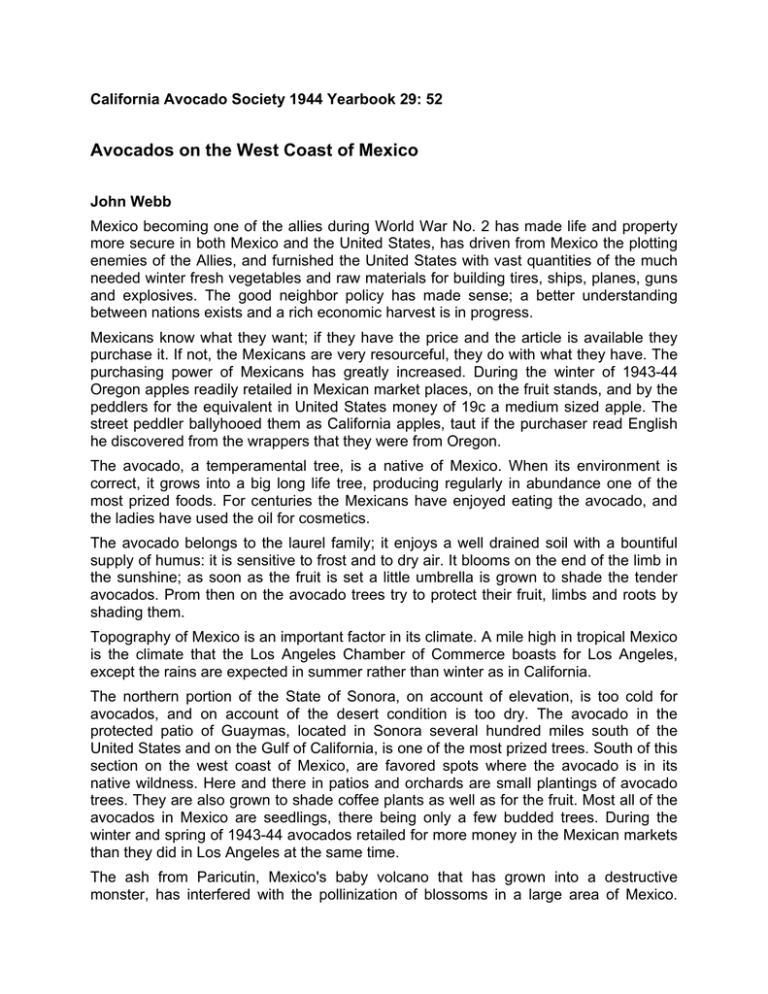Avocados on the West Coast of Mexico
advertisement

California Avocado Society 1944 Yearbook 29: 52 Avocados on the West Coast of Mexico John Webb Mexico becoming one of the allies during World War No. 2 has made life and property more secure in both Mexico and the United States, has driven from Mexico the plotting enemies of the Allies, and furnished the United States with vast quantities of the much needed winter fresh vegetables and raw materials for building tires, ships, planes, guns and explosives. The good neighbor policy has made sense; a better understanding between nations exists and a rich economic harvest is in progress. Mexicans know what they want; if they have the price and the article is available they purchase it. If not, the Mexicans are very resourceful, they do with what they have. The purchasing power of Mexicans has greatly increased. During the winter of 1943-44 Oregon apples readily retailed in Mexican market places, on the fruit stands, and by the peddlers for the equivalent in United States money of 19c a medium sized apple. The street peddler ballyhooed them as California apples, taut if the purchaser read English he discovered from the wrappers that they were from Oregon. The avocado, a temperamental tree, is a native of Mexico. When its environment is correct, it grows into a big long life tree, producing regularly in abundance one of the most prized foods. For centuries the Mexicans have enjoyed eating the avocado, and the ladies have used the oil for cosmetics. The avocado belongs to the laurel family; it enjoys a well drained soil with a bountiful supply of humus: it is sensitive to frost and to dry air. It blooms on the end of the limb in the sunshine; as soon as the fruit is set a little umbrella is grown to shade the tender avocados. Prom then on the avocado trees try to protect their fruit, limbs and roots by shading them. Topography of Mexico is an important factor in its climate. A mile high in tropical Mexico is the climate that the Los Angeles Chamber of Commerce boasts for Los Angeles, except the rains are expected in summer rather than winter as in California. The northern portion of the State of Sonora, on account of elevation, is too cold for avocados, and on account of the desert condition is too dry. The avocado in the protected patio of Guaymas, located in Sonora several hundred miles south of the United States and on the Gulf of California, is one of the most prized trees. South of this section on the west coast of Mexico, are favored spots where the avocado is in its native wildness. Here and there in patios and orchards are small plantings of avocado trees. They are also grown to shade coffee plants as well as for the fruit. Most all of the avocados in Mexico are seedlings, there being only a few budded trees. During the winter and spring of 1943-44 avocados retailed for more money in the Mexican markets than they did in Los Angeles at the same time. The ash from Paricutin, Mexico's baby volcano that has grown into a destructive monster, has interfered with the pollinization of blossoms in a large area of Mexico. Among these blossoms are many of the avocado tree. The grand avocado planting near Uruapan shading coffee plants has trees a hundred feet high and five feet in diameter on which this season there was not a fruit. The reduced production of avocados in Mexico during last year may have been responsible partly for the high price of the fruit, but in my opinion it was the increased purchasing power of the people who know the avocado and appreciate it. The Mexican avocado growers say they cannot produce as much fruit per acre in Mexico as some avocado growers produce per acre in California. It is the writer's opinion, some of the California avocado growers, with California technique, could grow avocados as abundantly in Mexico as they do in California.



